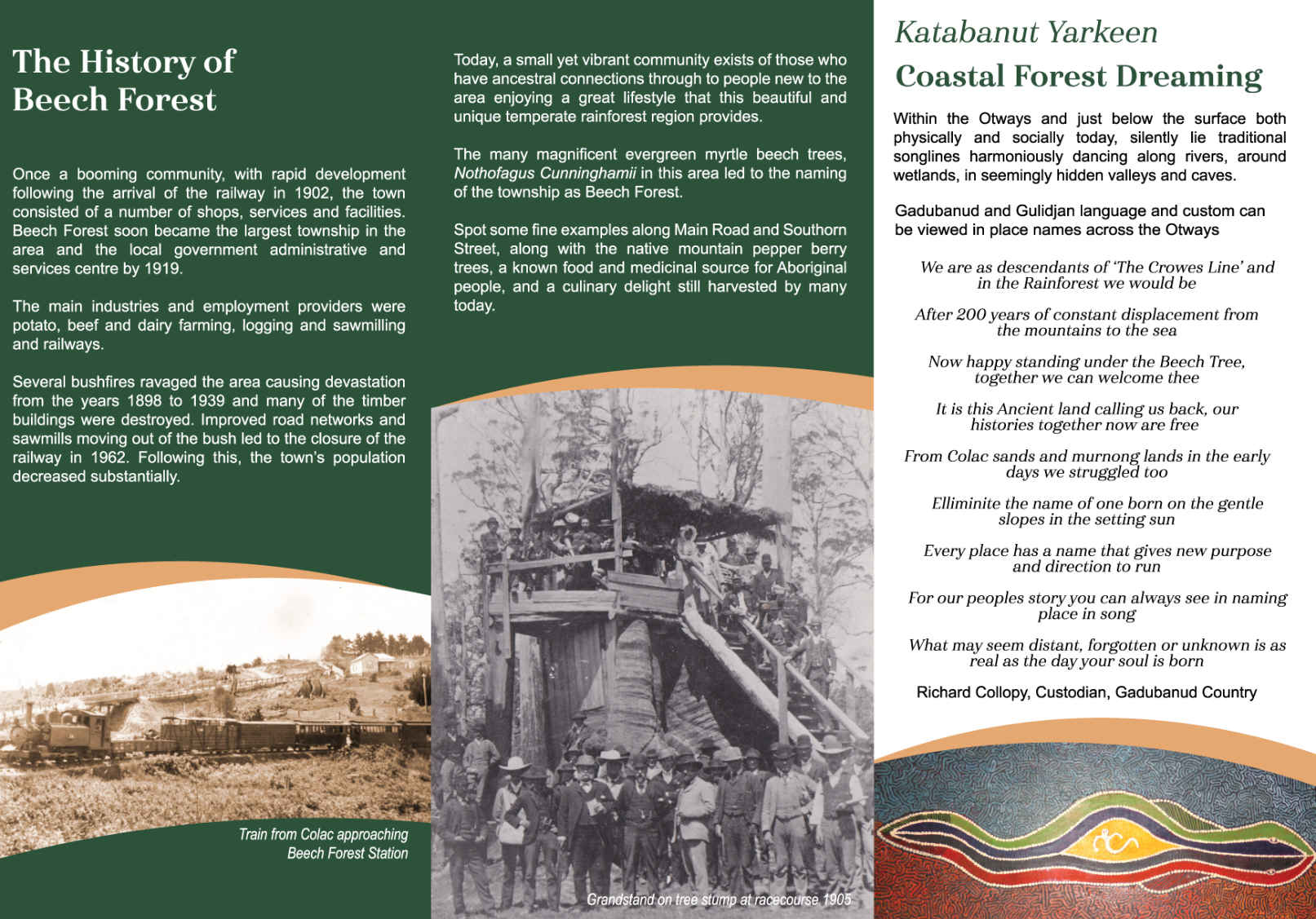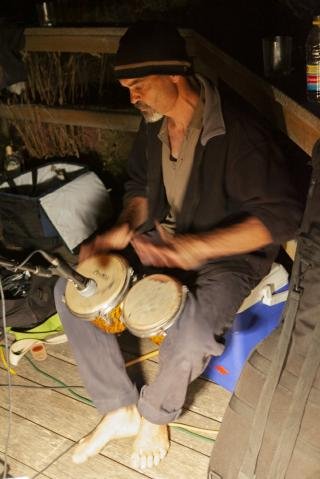Artworks and Projects.
"In the aboriginal worldview, everything is living. So everything is a manifestation of some other living part. And, of course, with objects that are made, then they're made by somebody and invested from the person who's making it and everyone who came before, like the ancestors...So what you make, why you make it, when you make it, is all part of this ancestral cycle of life." -Margo Neale in First Knowledges 'Design: Building on Country.'
Projects




Cape Otway Talking Hut.
-
Between 2006 and 2008 Richard undertook an Indigenous Heritage Project at Cape Otway as Design and Construct Project Manager. This involved the employment of 23 indigenous workers/artists. There are various sculptures, a talking hut for education and a walking track to avoid/protect but also to describe Middens; additionally a keeping place was created and also several paintings.
The Talking Hut was a great educational and cultural resource as part of the Cape Otway Light Station precinct for many years. Sadly it closed during the pandemic and is yet to reopen.
In 2022 Amy Tsilemanis did an interview with Richard on the site, published in Issue 16 The Otway Light 3/06/2022 (article reproduced below)
-
“In the aboriginal worldview, everything is living. So everything is a manifestation of some other living part. And, of course, with objects that are made, then they’re made by somebody and invested from the person who’s making it and everyone who came before, like the ancestors…So what you make, why you make it, when you make it, is all part of this ancestral cycle of life.” -Margo Neale in First Knowledges ‘Design: Building on Country.’
I arrive through the paths of coastal ti-tree at the hut, alone but for a light rain and the birds. The hut is circular, hand-made with local materials and strangely welcoming amidst its empty, abandoned air. It has no doors, no locks, artefact cases holding only labels, and covered in a layer of disuse. One case reveals a message (a plea?) written with a fingertip through the dust: ‘Please re-open the Talking Hut. We need these spaces.’ I walk past the grime covered information sheets ‘Aboriginal Ground Edge Axes,’ ‘Aboriginal Coastal Shell Middens,’ a broken chair, a fire extinguisher, a Covid sign attached to a branch with a cable tie, greenery coming in through the round, open windows sculpted out of the hut itself, a place to sit half inside half outside. I see the old information board shoved into a makeshift cupboard that states ‘The shells are fragile, the story is precious.’ Empty as the hut appears, I know that there is life here yet. Like Margo Neale’s words above, life has been transferred into the walls, the spiral roof, and the walking track outside. This Talking Hut still has more to hear, more to say.
Today I am lucky to be meeting with the artist and builder behind this special place, Richard Collopy and family. They are Traditional Custodians, and when they arrive they show me a map on the wall of Victoria’s almost forty Indigenous language groups, explaining how Victoria is language rich due to the fertile land. They point out the southern Gunditj (groups) of the Otways area, all surviving.
We sit on the carved wooden seats around the fire pit. As we talk, the rainfall deepens. Despite the lack of a fire, there’s a sense of cosiness, of hearth, though also of something once lively, sleeping and dusted with days untouched, waiting for its moment to return. As Richard says, it is culture waiting to be reinvigorated. The hut has been closed since Covid disruptions at the Cape Otway Light Station and the Collopy’s are hopeful for a renewed relationship with the site as operations are handed over from private operators to the government body and public land manager Great Ocean Road Coast and Parks Authority (GORCAPA) next month.
Going back over a decade Richard tells me how “knowing that surrounding sites and this place were very unprotected, and with no profile for Aboriginal people, we sought a grant to put our presence here.” With their business they received a federal government grant to create a keeping place for significant cultural artefacts, the hut and a kilometre long walking track. Richard states that “supported by the Light Station business, we established a collective working group including individuals from variant indigenous families, community orgs and others. As Project Manager, this is a role I had experience in before.”
The project sought to bring together the complex threads of recognising the long history preceding European settlement, and the continuing lines of Traditional Custodians like the Gadubanud surviving, despite horrific massacres and displacement due to colonisation. There is much healing to be done, which involves truth-telling to correct historical narratives of ‘savagery’ and ‘extinction,’ and sharing the rich culture and knowledge of the world’s first peoples and their unique stories of the Cape Otway area. These were all drivers in creating the hut, and driving preservation of significant artefacts that tell these stories.
So how did Richard go about building the Talking Hut and what are some of the ideas and symbols within?
“Once we decided to make something here, it took about a year and a half and a bit to see what you’ve got here. All done by hand with second-hand materials, up to thirty individuals helped. I loved building it, we had all our children here, some people that we’ve now lost, they’ve all touched it.” Richard tells the story of crawling on his knees through the bush to this spot where there was nothing, and of using his unique design and building process, where existing materials are shaped and reimagined through a person’s creativity, “tactile and sculptural.”
“I walked out here into the bush, there was nothing here, and I found a bunch of rubbish. There were bits of rock, there were hundreds of bottles, plenty of ti-tree that had to be cut.” Mixed with timber from his own property nearby, the hut was lovingly constructed, large enough for meetings, and inspired by traditional techniques where:
“In some larger huts a timber pole [tree] in the centre was turned upside down so that the roots would form the structure, rocks were built up to about a metre then the timber from the top joins down and the whole lot is covered in grass or sodden, like the thatched technique, then mud and every year your shells that you burn would go on, so they’d need to be re-rendered each year for thousands of years, and that gives it the sense of permanence. The huts are permanent, the people not so much, that’s the difference.”
Standing outside in the rain and looking at the hut I ask about the Y shape at the peak of the roof. Richard tells me about this symbol, in a shape like a whale’s tail: “it features in the hut, the entrance sign and on our clapsticks and this is about people helping each other. The symbology of that today is about the two cultures working together as one. That was the essence of that.”
I thank Richard very much for sharing his story and here’s to an exciting new phase at the Cape Otway Light Station. I will leave you with some of his brother’s wise words: “Relationships are at the basis of everything, and if we can get that right, things will prosper.” Cheers to that!







Apollo Bay Museum.
-
Richard has collaborated with the Apollo Bay Museum on a First Nations display featuring artefacts and stories. Listen to him discussing local history and middens as collective story here.
-




Lorne Sculptural Festival.
-
Richard has been a collaborating artist and advisor for this unique biannual event and is a participating artist and cultural advisor for the 2025 event themed Strata.
Lorne Sculpture Biennale 2025 will build on previous iterations to showcase a series of site-responsive artworks, commissioning established and emerging artists to explore how contemporary art can respond to, articulate, and augment our experience of place.
Curated by Simon Lawrie, LSB 2025’s artistic vision derives from the iconic geology of Gadubanud Country–the stratified landscape of the Great Ocean Road serves as an analogy for the fact that one place is many places, layered both physically and experientially through time, culture, and species.
Across 16 precincts from 1 – 30 March 2025, the outdoor exhibition will present sculpture and spatial installation more broadly, encompassing sonic art, architectural environments, ephemeral installations, and landscape interventions, all uniquely capable of enabling complex and affective experiences of place.
Throughout the Biennale, a suite of public programs, performances, and presentations titled Sculpture Plus will establish meaningful exchange and connection between artists, audiences, and communities. These will have a regional focus, providing opportunities for First Nations self-determination, skills development, strengthening collaborative partnerships, and celebrating the Surf Coast's arts and cultural networks.
-
Explore these videos from the 2022 event:
WELCOME by Richard Collopy
Embed- https://vimeo.com/669672248
WATER CIRCLE STORY with RICHARD COLLOPY
Embed- https://vimeo.com/671844029

















Heart Maps
-
In 2023 Richard was a collaborating artist and cultural advisor on this multi-layered mapping and audio storytelling project working with Amy Tsilemanis and the Apollo Bay Museum.
There were creative walking workshops where Richard took participants on a beach wander sharing stories of the local ecology and cultural history.
A piece captured from that day with imagery by Jade Forest and poem by Amy Tsilemanis called Good People Dreaming
There was a creative residency at the museum house, former site of the Cable Station residence where oral histories were collected and community were invited to come and engage with the project.
Finally there were two Heart Maps offerings at the 2023 WinterWild Fesival in Apollo Bay
explore all the created content below
-
The full picture
https://amytsilemanis.com.au/portfolio/heart-maps
Explore the Heart Maps audio adventure for Winter Wild festival 2023
Heart Maps Story Trail

Otway and District Historical Society.
-
Richard took part in the Society’s exciting new Beech Forest Historic Walking and Driving Tour.
Check out the links
-
The Beech Forest Walking Tour.
“Enjoy your walk through the Beech Forest township, let your imagination run wild as to what life was like in this area for First Nation people and those who settled on this land from 1884. This historic self guided tour takes you on a discovery adventure on Gadubanud country. The Otway Districts Historical Society respectfully acknowledges the Gadubanud people as the traditional custodians of the land and we pay our respect to Elders past present and emerging. We gratefully acknowledge the Local History Grants Program and Public Record Office Victoria, supported by the Victorian Government through the Community Support Fund.”
https://www.youtube.com/watch?v=BMkQNpG6N7k&feature=youtu.be
“The first Open Discussion in the Beech Forest History Series, Richard Collopy, Traditional Owner, Gadubanud Country discusses through his work, Coastal Forest Dreaming, the history of the Otways. He further discusses Pirt Koorroot, ancestors, songlines, Otway seasons and more.”
https://www.youtube.com/watch?v=B6UD4pi2He0&ab_channel=OtwayHistory




Musical Collabs
-
Richard regularly collaborates with local musicians and mentors local students.
Photos in folder
Check out a recent collaboration with Jamo
‘Together’ features vocals from the very talented @steve_cousins_music which holds such a powerful message, so for this song we set out to make something truly special for the visual; To convey a narrative that celebrates the profound beauty of human connection, transcending backgrounds and beliefs. A story of elevating our culture through the healing power of dance music, a testament to the transformative power of connection, painting a future where unity flourishes and judgment dissipates into the ether.
-
MaNNaGuM is a new musical duo that fuses traditional Aboriginal sounds with contemporary musical elements to create a rich tapestry of auditory experiences. Comprised of vocalist/percussionists and artist Richard Collopy and producer/multi-instrumentalist Vincent Melzak, MaNNaGuM draws on a diverse range of influences to craft their unique sound.
https://mannagum.bandcamp.com/community
JÄMO - Together (feat. Steve Cousins)
Richard Collopy
Artist Gallery
















